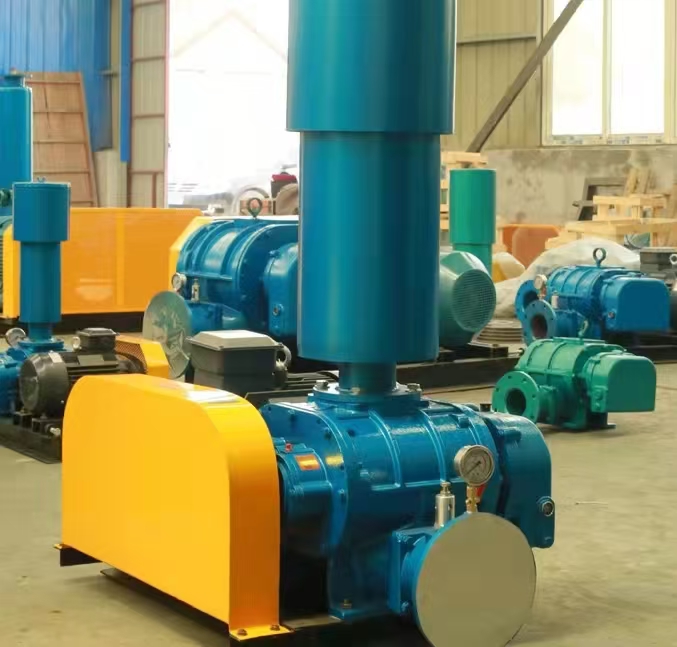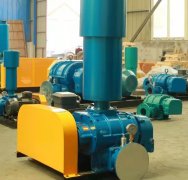The following is a detailed anatomical diagram and analysis of the core components of the Roots blower muffler, helping you to intuitively understand its internal structure and noise reduction principle:
---

**1、 3D anatomy diagram of muffler (section)**
```plaintext
[Inlet flange]
│
∝ -- Airflow direction
│
│ +---------------------------------------+
│ | Shell: 2mm carbon steel/1.5mm stainless steel (double-layer structure)|
│ | ├─────────────────┤
│ | |: Resistance silencing unit|
│ | | ┌─────────────────┐ |
│ | | │ Expansion chamber (section mutation ratio 3:1) │ | → Reflection 63-500Hz low frequency
│ | | │ Resonant cavity (Helmholtz structure) │|
│ | | └─────────────────┘ |
│ | ├─────────────────┤
│ | | Level 2: Resistive silencing unit|
│ | | ┌─────────────────┐ |
│ | | │ 50mm glass wool (density 48kg/m3) │ | → absorbs 500-4kHz medium and high frequencies
│ | | │ 0.8mm micro perforated plate (perforation rate 2) │|
│ | | └─────────────────┘ |
│ | ├─────────────────┤
│ | | Level 3: Airflow homogenization layer|
│ | | ┌─────────────────┐ |
│ | | │ Guide cone (30 ° inclination angle) │ | → Reduce turbulence regeneration noise
│ | | └─────────────────┘ |
│ | └─────────────────┤
│ | Drainage valve (DN20, bottom tilted 5 °)|
│ +---------------------------------------+
│
[Exhaust flange]
```
---
**2、 Functional Description of Core Components**
**1. Resistance silencing unit (low-frequency control)**
-Expansion Room:
-Reflection of sound waves through sudden expansion → contraction of the cross-section (area ratio 3:1)
-Formula for calculating noise reduction:
$$
\Delta L = 10\lg\left[1+\frac{1}{4}\left(m-\frac{1}{m}\right)^2\sin^2(kl)\right]
$$
(m=expansion ratio, k=wavenumber, l=cavity length)
-* * Resonance cavity * *:
-Helmholtz resonators for specific frequencies (such as 250Hz)
-Resonance frequency calculation:
$$
f_0 = \frac{c}{2\pi}\sqrt{\frac{\sigma}{V \cdot l_e}}
$$
(c=sound velocity, σ=neck area, V=cavity volume, l_e=effective neck length)
**2. Resistive silencing unit (medium high frequency control)**
|Material/Structure | Parameter Requirements | Mechanism of Action|
|----------------|-----------------------|--------------------------|
|Ultra fine glass wool | thickness 50-100mm | dissipates sound energy through porous structure|
|Microperforated plate | Aperture 0.5-1mm, perforation rate 1-3 | Acoustic impedance matching to enhance high-frequency absorption|
|Airflow channel | Flow rate ≤ 15m/s | Prevent regenerative noise|
**3. Auxiliary structure**
-* * Guiding cone * *: Optimize airflow distribution and reduce vortices (pressure loss reduced by 20%)
-* * Drainage system * *: prevent condensation water accumulation (electric heating drain valve is required for humidity>80)
---
**3、 Key performance parameters**
|Parameters | Standard Values | Testing Methods|
|-----------------|----------------------|-----------------------|
|Noise reduction level | 25-35dB (A) | GB/T 4760-1995|
|Pressure loss | ≤ 1.5kPa (rated flow) | ISO 5801|
|Fire rating | Grade A (GB 8624) | Vertical combustion test|
|Effective lifespan | 5-8 years (under normal operating conditions) | Aging test of sound-absorbing materials|
---
**4、 Special design variants**
**1. Explosion proof muffler**
-Structural features:
-Thicken the shell to 6mm (carbon steel)/4mm (stainless steel)
-Anti static sound-absorbing cotton (surface resistance ≤ 10 Ω)
-Applicable scenarios: biogas transportation, chemical flammable gases
**2. High temperature muffler**
-Material replacement:
-Sound absorbing layer: ceramic fiber cotton (temperature resistant to 800 ℃)
-Shell: 310S stainless steel
-Typical applications: boiler blowing, high-temperature exhaust gas treatment
**3. Medical silent type**
-Sanitary design:
-Full 316L stainless steel structure
-Detachable filter screen (convenient)
-Noise standard: ≤ 60dB (A) (at a distance of 1m)
---
**5、 Anatomy icon annotation explanation**
! [Dissection diagram of muffler]( https://example.com/silencer-cutaway )
-Red Arrow: Airflow Path
-* * Yellow area * *: Resistance silencing unit (low-frequency control)
-* * Blue area * *: Resistive silencing unit (medium high frequency control)
-Green Label: Maintenance Interface (Inspection Port/Drainage Valve)
---
**6、 Selection and Design Process**
1. * * Determine the noise spectrum * *:
-Measurement of 63Hz-8kHz octave band noise using a sound level meter
2. * * Calculate the noise reduction amount * *:
-Select the number of expansion chamber stages according to the target noise reduction value (6-10dB noise reduction per stage)
3. * * Verify pressure loss * *:
-Ensure that the total pressure loss is ≤ 10% of the allowable back pressure of the fan
---
**7、 Maintenance points**
|Components | Maintenance cycle | Operating standards|
|----------------|---------------|--------------------------|
|Acoustic material | Replace clumped/moldy glass wool every 2 years ||
|Micro perforated plate | Every 6 months | Compressed air blowback (pressure ≤ 0.3MPa)|
|Drainage valve | Monthly | Manual opening and closing test|
---
**Summary * *:
The design of Roots blower muffler needs to take into account both acoustic performance and fluid characteristics, and achieve wideband noise reduction through a composite structure of resistance and resistance. In practical applications, it is necessary to consider:
-Selection of noise spectrum characteristics and cavity size
-Determine the material properties of the medium (corrosion/explosion/hygiene)
-Space constraint optimized appearance (vertical/horizontal)
Suppliers who provide CAD drawings and CFD flow field simulation reports are more trustworthy. For key projects, it is recommended to conduct third-party noise testing and acceptance.



